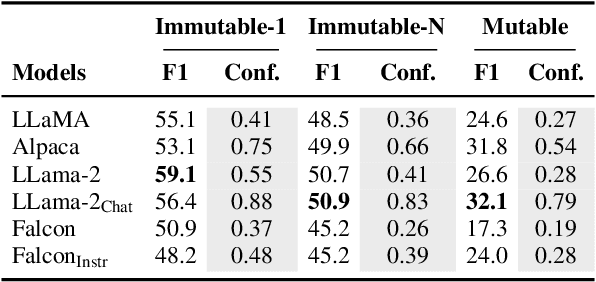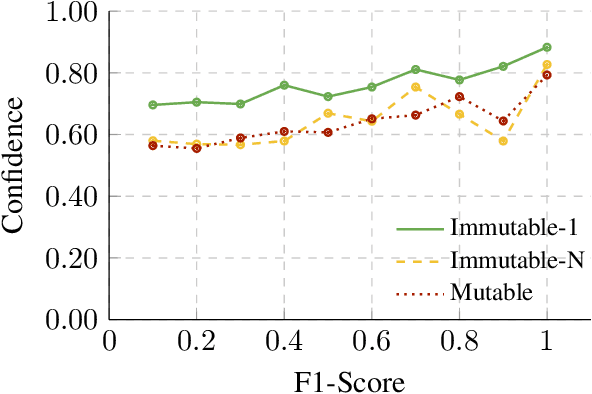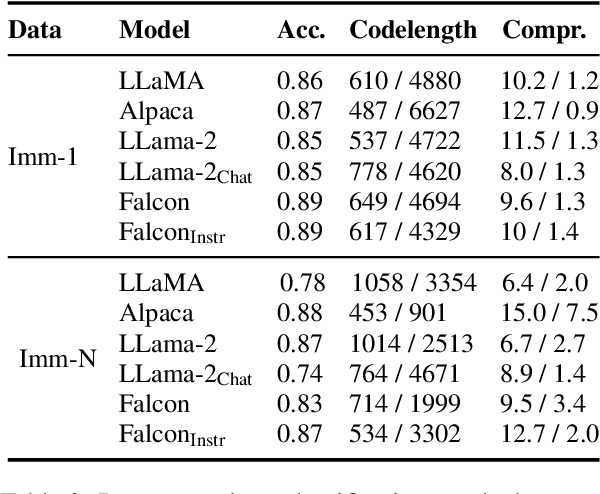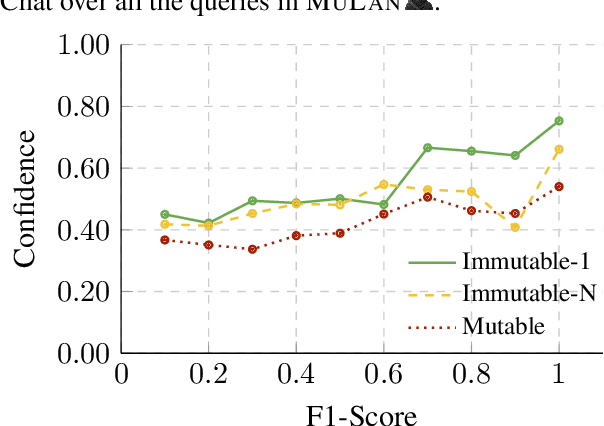Yova Kementchedjhieva
Overcoming Vocabulary Constraints with Pixel-level Fallback
Apr 02, 2025Abstract:Subword tokenization requires balancing computational efficiency and vocabulary coverage, which often leads to suboptimal performance on languages and scripts not prioritized during training. We propose to augment pretrained language models with a vocabulary-free encoder that generates input embeddings from text rendered as pixels. Through experiments on English-centric language models, we demonstrate that our approach substantially improves machine translation performance and facilitates effective cross-lingual transfer, outperforming tokenizer-based methods. Furthermore, we find that pixel-based representations outperform byte-level approaches and standard vocabulary expansion. Our approach enhances the multilingual capabilities of monolingual language models without extensive retraining and reduces decoding latency via input compression.
JEEM: Vision-Language Understanding in Four Arabic Dialects
Mar 27, 2025Abstract:We introduce JEEM, a benchmark designed to evaluate Vision-Language Models (VLMs) on visual understanding across four Arabic-speaking countries: Jordan, The Emirates, Egypt, and Morocco. JEEM includes the tasks of image captioning and visual question answering, and features culturally rich and regionally diverse content. This dataset aims to assess the ability of VLMs to generalize across dialects and accurately interpret cultural elements in visual contexts. In an evaluation of five prominent open-source Arabic VLMs and GPT-4V, we find that the Arabic VLMs consistently underperform, struggling with both visual understanding and dialect-specific generation. While GPT-4V ranks best in this comparison, the model's linguistic competence varies across dialects, and its visual understanding capabilities lag behind. This underscores the need for more inclusive models and the value of culturally-diverse evaluation paradigms.
Noise is an Efficient Learner for Zero-Shot Vision-Language Models
Feb 09, 2025Abstract:Recently, test-time adaptation has garnered attention as a method for tuning models without labeled data. The conventional modus operandi for adapting pre-trained vision-language models (VLMs) during test-time primarily focuses on tuning learnable prompts; however, this approach overlooks potential distribution shifts in the visual representations themselves. In this work, we address this limitation by introducing Test-Time Noise Tuning (TNT), a novel method for handling unpredictable shifts in the visual space. TNT leverages, for the first time, a noise adaptation strategy that optimizes learnable noise directly in the visual input space, enabling adaptive feature learning from a single test sample. We further introduce a novel approach for inter-view representation alignment by explicitly enforcing coherence in embedding distances, ensuring consistent feature representations across views. Combined with scaled logits and confident view selection at inference, TNT substantially enhances VLM generalization and calibration, achieving average gains of +7.38% on natural distributions benchmark and +0.80% on cross-dataset evaluations over zero-shot CLIP. These improvements lay a strong foundation for adaptive out-of-distribution handling.
EFSA: Episodic Few-Shot Adaptation for Text-to-Image Retrieval
Nov 28, 2024Abstract:Text-to-image retrieval is a critical task for managing diverse visual content, but common benchmarks for the task rely on small, single-domain datasets that fail to capture real-world complexity. Pre-trained vision-language models tend to perform well with easy negatives but struggle with hard negatives--visually similar yet incorrect images--especially in open-domain scenarios. To address this, we introduce Episodic Few-Shot Adaptation (EFSA), a novel test-time framework that adapts pre-trained models dynamically to a query's domain by fine-tuning on top-k retrieved candidates and synthetic captions generated for them. EFSA improves performance across diverse domains while preserving generalization, as shown in evaluations on queries from eight highly distinct visual domains and an open-domain retrieval pool of over one million images. Our work highlights the potential of episodic few-shot adaptation to enhance robustness in the critical and understudied task of open-domain text-to-image retrieval.
CVQA: Culturally-diverse Multilingual Visual Question Answering Benchmark
Jun 10, 2024



Abstract:Visual Question Answering (VQA) is an important task in multimodal AI, and it is often used to test the ability of vision-language models to understand and reason on knowledge present in both visual and textual data. However, most of the current VQA models use datasets that are primarily focused on English and a few major world languages, with images that are typically Western-centric. While recent efforts have tried to increase the number of languages covered on VQA datasets, they still lack diversity in low-resource languages. More importantly, although these datasets often extend their linguistic range via translation or some other approaches, they usually keep images the same, resulting in narrow cultural representation. To address these limitations, we construct CVQA, a new Culturally-diverse multilingual Visual Question Answering benchmark, designed to cover a rich set of languages and cultures, where we engage native speakers and cultural experts in the data collection process. As a result, CVQA includes culturally-driven images and questions from across 28 countries on four continents, covering 26 languages with 11 scripts, providing a total of 9k questions. We then benchmark several Multimodal Large Language Models (MLLMs) on CVQA, and show that the dataset is challenging for the current state-of-the-art models. This benchmark can serve as a probing evaluation suite for assessing the cultural capability and bias of multimodal models and hopefully encourage more research efforts toward increasing cultural awareness and linguistic diversity in this field.
MuLan: A Study of Fact Mutability in Language Models
Apr 03, 2024



Abstract:Facts are subject to contingencies and can be true or false in different circumstances. One such contingency is time, wherein some facts mutate over a given period, e.g., the president of a country or the winner of a championship. Trustworthy language models ideally identify mutable facts as such and process them accordingly. We create MuLan, a benchmark for evaluating the ability of English language models to anticipate time-contingency, covering both 1:1 and 1:N relations. We hypothesize that mutable facts are encoded differently than immutable ones, hence being easier to update. In a detailed evaluation of six popular large language models, we consistently find differences in the LLMs' confidence, representations, and update behavior, depending on the mutability of a fact. Our findings should inform future work on the injection of and induction of time-contingent knowledge to/from LLMs.
Multimodal Large Language Models to Support Real-World Fact-Checking
Mar 06, 2024Abstract:Multimodal large language models (MLLMs) carry the potential to support humans in processing vast amounts of information. While MLLMs are already being used as a fact-checking tool, their abilities and limitations in this regard are understudied. Here is aim to bridge this gap. In particular, we propose a framework for systematically assessing the capacity of current multimodal models to facilitate real-world fact-checking. Our methodology is evidence-free, leveraging only these models' intrinsic knowledge and reasoning capabilities. By designing prompts that extract models' predictions, explanations, and confidence levels, we delve into research questions concerning model accuracy, robustness, and reasons for failure. We empirically find that (1) GPT-4V exhibits superior performance in identifying malicious and misleading multimodal claims, with the ability to explain the unreasonable aspects and underlying motives, and (2) existing open-source models exhibit strong biases and are highly sensitive to the prompt. Our study offers insights into combating false multimodal information and building secure, trustworthy multimodal models. To the best of our knowledge, we are the first to evaluate MLLMs for real-world fact-checking.
Answerability in Retrieval-Augmented Open-Domain Question Answering
Mar 03, 2024Abstract:The performance of Open-Domain Question Answering (ODQA) retrieval systems can exhibit sub-optimal behavior, providing text excerpts with varying degrees of irrelevance. Unfortunately, many existing ODQA datasets lack examples specifically targeting the identification of irrelevant text excerpts. Previous attempts to address this gap have relied on a simplistic approach of pairing questions with random text excerpts. This paper aims to investigate the effectiveness of models trained using this randomized strategy, uncovering an important limitation in their ability to generalize to irrelevant text excerpts with high semantic overlap. As a result, we observed a substantial decrease in predictive accuracy, from 98% to 1%. To address this limitation, we discovered an efficient approach for training models to recognize such excerpts. By leveraging unanswerable pairs from the SQuAD 2.0 dataset, our models achieve a nearly perfect (~100%) accuracy when confronted with these challenging text excerpts.
Cultural Adaptation of Recipes
Oct 26, 2023Abstract:Building upon the considerable advances in Large Language Models (LLMs), we are now equipped to address more sophisticated tasks demanding a nuanced understanding of cross-cultural contexts. A key example is recipe adaptation, which goes beyond simple translation to include a grasp of ingredients, culinary techniques, and dietary preferences specific to a given culture. We introduce a new task involving the translation and cultural adaptation of recipes between Chinese and English-speaking cuisines. To support this investigation, we present CulturalRecipes, a unique dataset comprised of automatically paired recipes written in Mandarin Chinese and English. This dataset is further enriched with a human-written and curated test set. In this intricate task of cross-cultural recipe adaptation, we evaluate the performance of various methods, including GPT-4 and other LLMs, traditional machine translation, and information retrieval techniques. Our comprehensive analysis includes both automatic and human evaluation metrics. While GPT-4 exhibits impressive abilities in adapting Chinese recipes into English, it still lags behind human expertise when translating English recipes into Chinese. This underscores the multifaceted nature of cultural adaptations. We anticipate that these insights will significantly contribute to future research on culturally-aware language models and their practical application in culturally diverse contexts.
Large Language Models Converge on Brain-Like Word Representations
Jun 02, 2023Abstract:One of the greatest puzzles of all time is how understanding arises from neural mechanics. Our brains are networks of billions of biological neurons transmitting chemical and electrical signals along their connections. Large language models are networks of millions or billions of digital neurons, implementing functions that read the output of other functions in complex networks. The failure to see how meaning would arise from such mechanics has led many cognitive scientists and philosophers to various forms of dualism -- and many artificial intelligence researchers to dismiss large language models as stochastic parrots or jpeg-like compressions of text corpora. We show that human-like representations arise in large language models. Specifically, the larger neural language models get, the more their representations are structurally similar to neural response measurements from brain imaging.
 Add to Chrome
Add to Chrome Add to Firefox
Add to Firefox Add to Edge
Add to Edge